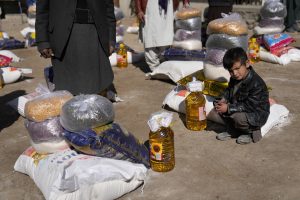Any visitor to Kabul is struck by the number of people begging. Women stand or sit in the middle of roads. Children approach cars in traffic. When I once handed out some biscuits, the crowd was immediate. Guards chased people away and wanted the biscuits too.
Hunger is everywhere. In response, the Afghan Red Crescent wants to support the growing numbers of destitute in Kabul. This will involve providing food, shelter, protection, and assistance to restart livelihoods. They will need money to do it, and that may be a problem. Not because there is no money for aid, but because national humanitarian organizations, however good their ideas, will be at the end of the line to receive it.
The pledging conference to be hosted by the United Kingdom and Germany on March 31 is unlikely to rectify that, partly because all eyes are on Ukraine, but also because the donor community will invest solely in international organizations to deliver essential food and medicine. This will address short-term needs while leaving Afghanistan with little ownership or capacity to manage the social protection of its citizens.
This strategy is rooted in the conviction that lifesaving assistance is acceptable, but anything longer term must be tied to government progress on human rights. So, while investment may be forthcoming for medicines, food, water, and even direct payment of salaries and running costs for medical facilities and schools, other support will be held back, including anything that supports the ruling authorities or is part of a longer-term, development agenda.
Whatever the merits of this strategy, there must be efforts to mitigate two negative consequences. First, such an approach means that services may not be locally owned; and secondly, chronic needs shaping the country’s prospects, such as employment for youth and former fighters, will be neglected in favor of short-term needs only, leaving little hope for the country’s longer-term prospects.
One mitigation strategy is to invest as much as possible into non-state Afghan organizations, such as the Afghan Red Crescent. This is not attractive to donors because real Afghan organizations, as opposed to those constructed by international organizations to implement programs, mirror the society that produced them. Supporting them is perceived as involving some of the same risks as funding the Islamic Emirate of Afghanistan (IEA) authorities themselves. Most donors feel this is a hard sell to the public back home. Funding is therefore concentrated within a few international organizations instead.
But there are at least three good reasons why the international donor conference should promote investment in strong, national actors.
First, their diplomacy has a deeper and broader scope. Many humanitarians, including myself, have had high level engagement with IEA leaders over recent months. But whatever we agree upon in English over tea with the diplomatic face of the Taliban in ministries in Kabul, must then land in Pashtun and Dari with battle-hardened men shaped by madrassa schooling and promises of Shariah law. Afghan leaders will always be better at understanding where influence really lies and how to navigate it.
Second, while short-term survival needs are paramount, the drivers of Afghanistan’s future cannot be addressed through boxes of aid or a short-term commitment to pay salaries. Thorny issues such as the rights of women and girls, rehabilitation of drug users, integration of former fighters, and employment for youth need to be debated. Arguments need to be won across a range of stakeholders and ways forward owned within formal and informal power networks. That will not happen through a parallel, international aid system. Afghan leaders and Afghan institutions need to be the champions of the development agenda.
Third, with the right investment strategies, Afghan institutions such as the Afghan Red Crescent can endure political upheavals and deliver services even as governments change and despite ebbs and flows of international attention. Such institutions are the foundations stones of a national capacity to respond to sudden and chronic crises. Those foundations need to be preserved and built upon, not substituted.
At the very least then, even as diplomacy continues on recognition and conditionality of aid, part of the investment in the donor conference should go to such local institutions. This will ensure some seeds are sown for genuine, durable solutions to provide both for today’s needs and growing threats on the horizon.
The humanitarian crisis is severely affecting more than half the country’s population. It risks getting worse before it improves. It is more urgent than ever that Afghan national actors are placed center-stage to avoid old mistakes of building parallel systems with shallow foundations.

































